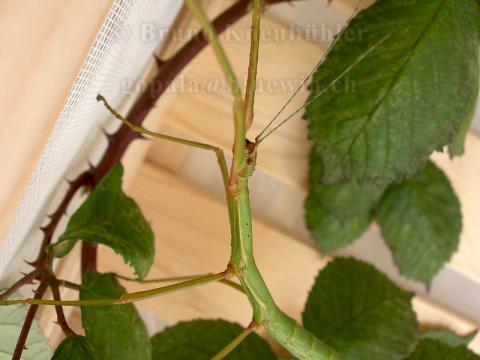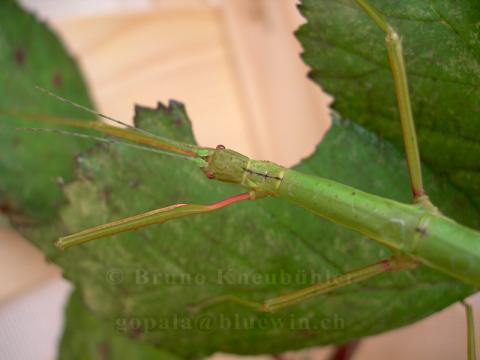
Genus
Species
Stock
Culture status
Probably lost
Foodplants
Bramble (Rubus spp.)
Firethorn (Pyracantha)
Eucalyptus spp.
Hypericum spp.
Lawson cypress (Cupressus lawsoniana)
Breeding notes
(by Bruno Kneubühler)
General Notes
- synonyms: Acanthoxyla prasina inermis (Salmon, 1991)
- this species is since quite some years in culture, though it is rarely cultured
- a species recommended to the more experienced breeder
- sometimes this species is also called Acanthoxyla prasina inermis
- this is a truely parthenogenetic species – only females are known from the wild
_________________
Orign
- Wellington, New Zealand
_________________
Females
- wingless phasmids, about 9 – 10 cm long
- when the females are ready to lay eggs, their abdomen becomes quite fat
- adult females are coloured beautifully bright green
- there is a thin black line on the back of the prothorax (dorsally), which extends just a little bit onto the head
- thin yellow lines are on the sides of the abdomial and thoracial segments (laterally)
- the inside of the frontlegs (part near to the body) is red
- feelers are about half long as the front legs
- there are a few small, spines on the thorax and the head – some of which are dark coloured
_________________
Eggs
- about 4 mm long, 2 mm wide
- the eggs are dark brown with an irregular rough surface
_________________
Food Plants
- they feed on bramble (Rubus sp.) and firethorn (Pyracantha sp.)
- other accepted food plants are Eucalyptus sp., Hypericum sp. and even Cupressus lawsoniana (= Chamaecyparis lawsoniana)
_________________
Breeding Notes
- eggs should be kept in the fridge for about 3-4 weeks at around 5 – 8 °C. In winter temperatures in New Zealand can also drop quite low. Therefore keeping the eggs for some time at cooler temperatures (hibernation period) seems to be advantagous for a healthy developement of the embryos
- keep the eggs on damp sand (or something similar), avoid them getting soaking wet
- incubation at room temperatures (18 – 25 °C) is fine
- eggs will hatch after about 4 months - but this depends of course on how long they have been kept at fridge temperatures
- trim the edges of the food plants for the newly hatched nymphs
- there is quite a high death rate amongst first instar nymphs
- keep nymphs quite dry in an airy cage (fauna box) at room temperatures (18 – 25°C)
- as this species originates from a temperate area, they may also be tolerate towards lower temperatures
- they mature in about 4-5 months, depending on the temperatures
- females just fling the eggs away, so they just drop on the ground
_________________
References
- Phasmida Species Files (www.phasmida.orthoptera.org)







